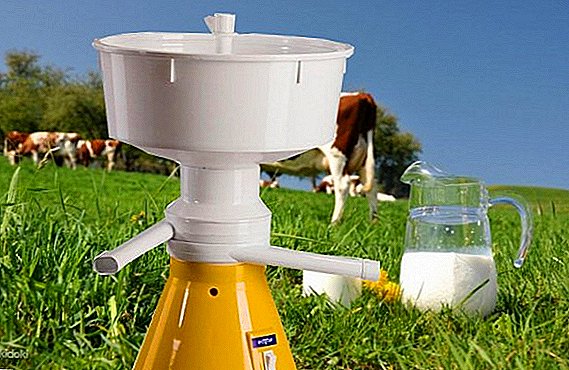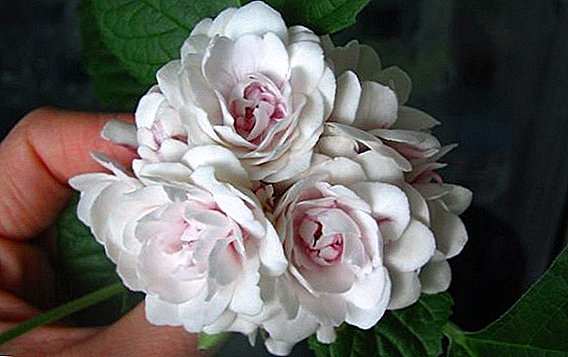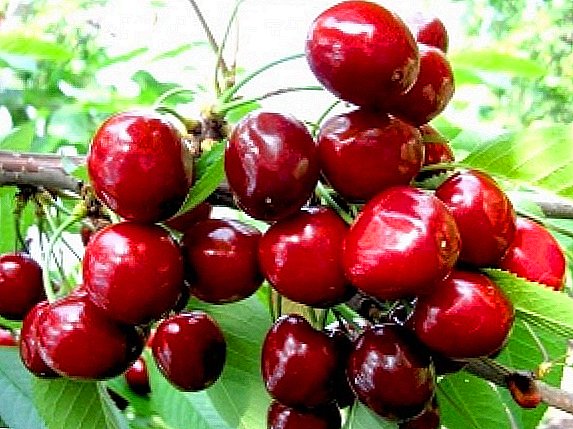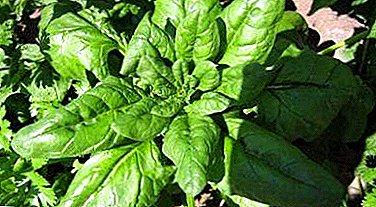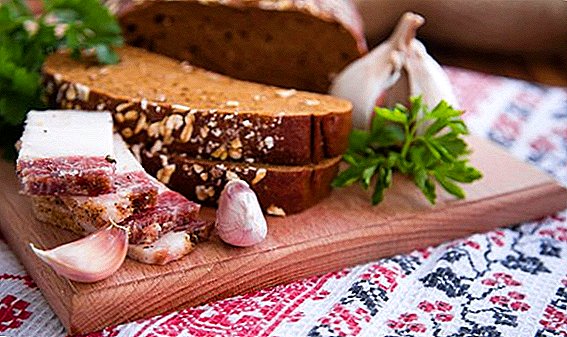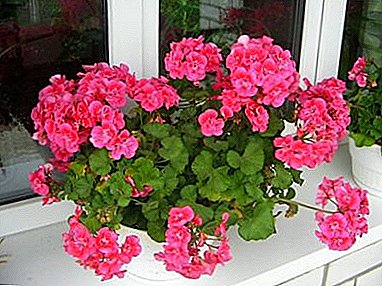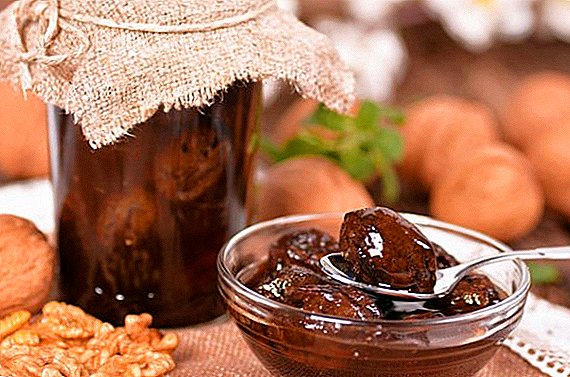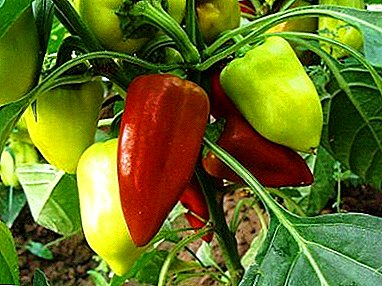
Sweet (Bulgarian) pepper - natural concentrate of vitamins, microelements, mineral salts, extractive substances, easily digestible carbohydrates.
This is a valuable product for preservation, as well as the basis of many delicious and healthy dishes.
The degree of his popularity can only be compared with his own exactingness to conditions of growth - soil, ambient temperature, light, moisture.
Pepper care in the ground
Sweet pepper for open ground: in order to get a good harvest of large, fleshy, juicy fruits, you should correctly approach all methods of cultivation of this crop and know their characteristics.
- Pepper gives the highest yields on light loamy chernozem and sandy sables.
- It is also demanding for crop rotation: it is desirable to grow it in one place for 1 year. As precursors should choose legumes and early vegetable plants.
- Ground for sweet pepper is prepared at the end of the garden season, loosening the soil to a depth of 30 cm, followed by the introduction of 3-4 kg / m² of overheated manure.
- Place for planting is prepared taking into account its placement in the scenes of high stem cultures. This makes it possible to reduce the negative impact of sharp temperature fluctuations on the growth of pepper, and also protects against wind.
Growing bell pepper seedlings method
How to grow bell pepper?
The most common breeding culture seedling method. It is recommended to grow seedlings in humus - earthen pots in order to avoid damage to the fragile root system of the plant.
The mixture for them is prepared as follows: for 8 parts of humus, take 2 parts of turf and 1 part of mullein with the addition of 40 g of superphosphate, 10 g of urea and 5 g of potassium sulphate per bucket. The optimal size of each pot is 60x60 mm.
Seed preparation
 By the time they are placed in the mix, the seed must be prepared.
By the time they are placed in the mix, the seed must be prepared.
- First of all, the most filled seeds are selected: they are poured into a container with water, stirred, allowed to settle, the surfaced seeds are removed, the water is poured through a fine-mesh sieve.
- The remaining material is dried, disinfected in a weak manganese solution, germinated on periodically moistened tissue before biting.
- Prepared seeds of 3 - 4 pieces are placed in moist pots, then sprinkled with a layer of earth 10 - 20 mm.
The right of the photo shows the seeds of sweet pepper.
Seedling care
For faster seed germination, boxes with future seedlings are placed in a well-lit place with a temperature:
- 25 - 30 ° С (it can be a window sill in a house or a greenhouse) before the emergence of shoots;
- after their appearance 10 - 15 ° С during the week;
- 20 - 25 ° С before planting seedlings in the ground.
Watering seedlings at least 2 days later, while avoiding stagnant moisture in the ground. Daily watering is required when the appearance of four - five true leaves.
Seedlings need to be fed. 50 g of superphosphate, 20 g of urea and 15 g of potassium sulfate are taken on a bucket of water. From organic fertilizers use fermented bird droppings or slurry. The application of organic and mineral fertilizers alternate. The first feeding is carried out in the phase of appearance of the first true leaf, re-fertilized in the phase of four to five leaves.
Planting seedlings in the ground, its watering and feeding
A very important agrotechnical method for growing peppers is planting seedlings in the ground.
- One to two weeks before planting seedlings start its quenching: reduce the temperature, limit watering, in order to improve the illumination; in the absence of the threat of frost, take out plants to the open air.
- 5 - 10 days before planting peppers in the ground they are sprayed with a 0.5% solution of copper sulfate to protect against fungal diseases.
- Peppers, suitable for planting in the ground, have 5 - 6 true leaves, strong stalk, developed root system.
- Before planting, seedlings are well watered.
Planted in the southern regions in the late days of April. In areas with lower temperatures for this period, it is advisable to choose the beginning of June at the time of landing.
In general, the whole cycle from the preparation of seeds to the planting of peppers into the ground takes 45 - 55 days while ensuring the correct mode of temperature, frequency compliance, as well as the quality of watering and feeding. Planting is carried out in an ordinary way with a feed area of 70x15 cm in one plant or 70x30 cm in two plants per well.
In the pre-watered wells they place the plants together with the earthy lump 1 - 1.5 cm deeper than the root collar, then sprinkle them with dry earth. The next day after the landing of the peppers in the ground they need to be watered again. Throughout the time of cultivation up to harvest, watering is repeated regularly, preventing the soil from drying out.
Important! The lack of moisture in the soil leads to:
- to fall off of flowers and ovaries;
- plant growth arrest;
- fetal disorders;
- significant yield reduction.
After watering, the soil is loosened, and it should be done carefully, going deeper by no more than 5 cm, paying special attention to the space near the stem.
Important! Fertilizers are applied during the growing season, depending on the state of the plants, avoiding nitrogen fertilizers that cause the growth of vegetative shoots and retard the formation of fruits.
But The first feeding is required 10 - 15 days after disembarkation: A mixture of 15 g of ammonium nitrate, 20 g of superphosphate and 5 g of potassium salt is applied per 1 m².
Such seedlings quicker and better to take root, gives a better and earlier harvest.
You can learn more about how to plant seedlings of sweet pepper in open ground, you can on the video below:
Growing pepper from seeds in the ground
 How to grow sweet Bulgarian pepper in the open field?
How to grow sweet Bulgarian pepper in the open field?
When growing sweet pepper in open ground in a non-seedling way, first of all a thoroughly leveled and chopped soil is required for sweet pepper.
Seeds of Bulgarian pepper for open ground are disinfected, but not germinated. The optimal time for planting seed is the second decade of April.
In case of unfriendly, late spring, when the terms of planting are shifted, the seeds are first germinated before biting.
How to plant Bulgarian pepper seeds?
In carefully leveled and ground soils make 8 - 10 holes per 1 m². In each of them, for faster germination, 4–5 seeds are heaped, with a seeding depth of 3–4 cm and subsequent mulching.
After the emergence of seedlings in the wells, usually 1 to 2 plants are left. With this method of growing further care for the plants is watering, loosening, weeding with the same rules and frequency as in the method of growing pepper seedlings.
Diseases and pests
 The fight against diseases and pests also plays a big role in the cultivation of pepper. Proper diagnosis of the disease and timely action will help preserve the crop and even prevent its death.
The fight against diseases and pests also plays a big role in the cultivation of pepper. Proper diagnosis of the disease and timely action will help preserve the crop and even prevent its death.
- Causative agent verticillary wilting is a fungus that lives in the soil. It penetrates the wounds of the root system of a plant when it is planted on the ground or excessively loosened.
Manifestation of the disease withering in the spotty lesion, withering, leaf fall and deformity of internodes. At the early stage of the disease, the plant does not form the ovaries, if the infection has occurred in the phase of fruit formation, the fruits frown and do not fill. Preventive measures- disinfection of soil, careful planting of seedlings along with an earthy clod, careful loosening of the soil.
- Late blight also caused by fungus. Affected areas in the form of brown spots with a pale green halo rot in wet weather. Prevention methods - timely planting of seedlings during the period of settled weather without the risk of a significant difference between day and night temperatures with the formation of strong condensate and its precipitation on plants.
- White rot (scleroteniosis). Fungal disease that develops in the root of the pepper. Symptoms are white bloom on the surface of the stem, and inside it - solid black formations that prevent the absorption of moisture and minerals from the soil.
White rot leads to the death of the plant. Preventive and therapeutic measures: timely cleaning of dead plants, moderate watering, dusting with ash or chalk with minor lesions, thermal disinfection of the soil.
- Gray rot. Plants cultivated in greenhouses are generally susceptible. Brown, moist spots with a gray bloom appear on the stem and leaves at high humidity and lowering the temperature to 10 ° C. Preventive measures - compliance with temperature and humidity, the requirements of crop rotation, weeding.
If gray mold has already manifested itself, remove all affected fruit. You can remove the gray rot by spraying the infusion of garlic: 30 g of crushed garlic for two days insist on a bucket of water. Spraying is also applied with industrial preparations of the corresponding spectrum of action.
- Vertex rot. Also a disease of greenhouse plants, bacterial or non-infectious origin. The first type of the disease is characterized by the appearance of gray spots, the second type is manifested in the form of watery green spots on the fruit. With the defeat of the resulting fruits do not ripen, and rot. Calcium nitrate is good at helping with the initial symptoms. Affected fruits are collected and destroyed.
- Blackleg. Damage to the root part of the stem of seedlings at low temperature and high humidity. The reasons are unprotected disinfection of seeds and non-compliance with the rules of their sowing on seedlings. Diseased plants are culled, the soil is treated with copper sulfate. As a preventive measure, seedlings can be sprayed with the drug "Phytodoc".
Pepper pest control is usually effective with insecticides.
- Aphid, accumulating on all organs of the plant, sucks nutrients and moisture from the tissues. A good result is given by spraying daily infusion of ash with the addition of soap per 10 liters of water, 1 cup of ash and 30 g of soap. Instead of ash, you can use smoking tobacco - 100 g per 10 liters of water. Such solutions process the plantation of pepper several times in the morning.
- Spider mite forms colonies on the lower part of the leaf of the plant. The defeat of the tick leads to disruption of vital and fruitful functions. To destroy the tick, spray the leaves with soap and water from below.
- Slugs cause great damage to the fruit, climbing inside them. The mechanical way of dealing with slugs is manual collection and destruction. The soil should be periodically pollinated with ash, slaked with lime or mustard powder. As a deterrent of these pests, parsley can be sown next to the pepper.
- Colorado beetle. Larvae, laid off by adult insects, devour the leaves. With a massive pest damage, this can lead to the complete destruction of the crown and the death of the plant. Beetles, larvae and eggs are harvested by hand. Pepper plantation can be treated with insecticides or celandine tincture.
More information about possible diseases and pests of sweet pepper you can find on the video below:
Harvesting and storage
 Harvest when ripe fruit: they are poured, acquire color and size, conditioned for a particular variety.
Harvest when ripe fruit: they are poured, acquire color and size, conditioned for a particular variety.
About ripeness can be judged by the characteristic sound when touching the fruit. The first collection is carried out in mid-July - early August. depending on the climatic zone of cultivation.
It is important to note that best to shoot the fruit in dry weather, so that the moisture on the harvested peppers does not lead to decay during storage. Peppers are removed without cutting the stem, which increases its shelf life without losing its taste.
For the entire season spend up to five fees. When forecasting frosts collect all the remaining fruits on the bushes for ripening them indoors.
How to save Bulgarian pepper?
Store the harvested peppers recommended at a relative humidity of 80 - 90% and a temperature of 8 - 10 ° C. The absence of defects and damage to the fruit increases their shelf life. Ripe peppers can be stored in refrigerators and basements for up to a month. It is possible to freeze the pepper as a way of preservation.
Getting seeds
When harvesting, you need to take care of the gene pool for the next season, because the germination of seeds from self-grown, in compliance with all the rules of plants reaches nearly 100%. From the selected, the most beautiful and large pepper core is extracted, seeds are separated from it. Seeds are dried naturally and stored in cotton bags for three to four years.
And a little more about breeding.
Important! Although pepper is a self-pollinating plant, cross-pollination is not excluded. Therefore, when growing different varieties of sweet peppers, it is necessary to isolate the plants left on the seeds.
Here it is, Bulgarian pepper - whimsical, capricious, time consuming. But with all the rules, grown carefully and with love, he will definitely give beautiful, juicy and sweet fruit.


